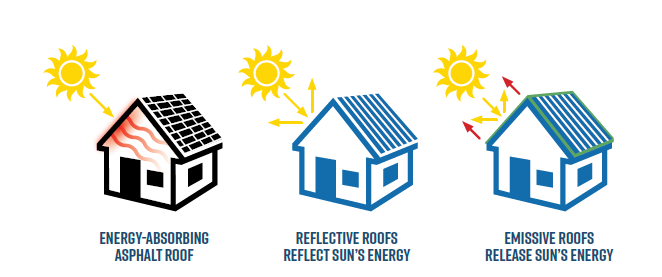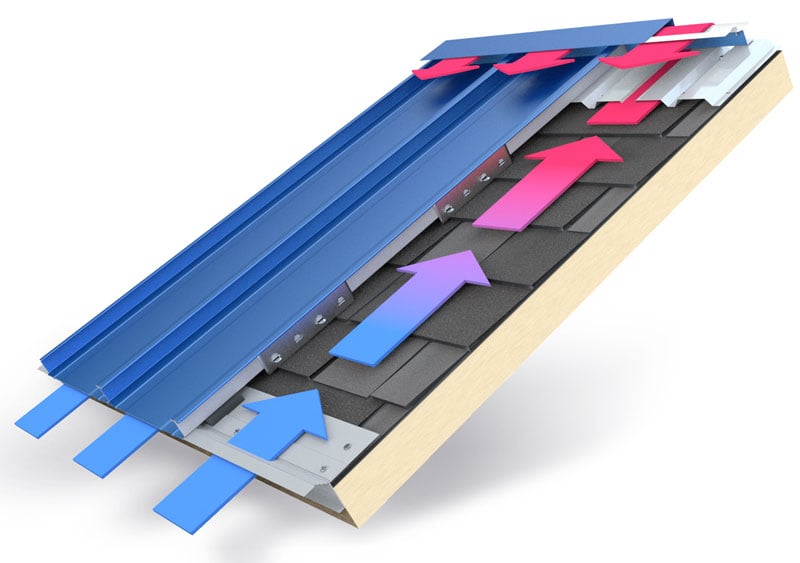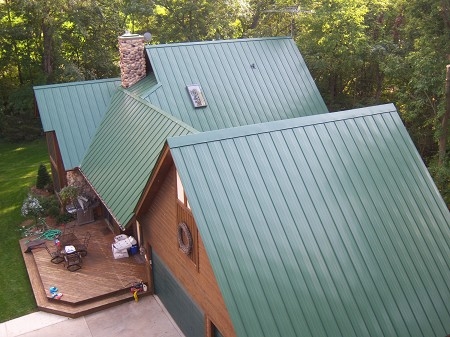Common Misconceptions about Heat Absorption and Metal Roofs
Many people think that metal roofs will make their homes hotter. That’s a myth, and it's one reason why more homeowners are opting for metal roofs.
Think of it this way: when it’s really hot outside and you touch a doorknob, for example, the doorknob will probably be pretty warm—maybe a lot warmer than its surroundings!
We’re going to debunk the myth about heat and metal roofs today, and we’re going to do it by looking at all the factors that make metal roofs excellent for cooling your home. That’s right - metal roofs will actually keep your home cooler than other roofing materials like asphalt. Let’s find out why:
Misconception #1: All metals are made equally
Different metals conduct heat differently. You could, for example, have a roof made entirely of copper. A totally copper roof would be an excellent conductor of heat. On the other hand, stainless steel is a very poor conductor of heat.
That means how conductive your roof is depends heavily on which metals were used in its construction.
Misconception #2: High heat conductivity is bad
Thinking that high conductivity is bad makes sense—after all, heat will transfer into your home, right?
Well, that’s actually not entirely accurate—as we’ll discuss in a later section. There’s something else to consider, though—what if you have a material that can absorb a lot of heat but has relatively low conductivity?
Think about asphalt on a hot day. Asphalt has very low conductivity compared to metal, but if you’re standing on asphalt barefoot, you’ll still get burned. Moreover, asphalt slowly releases all that heat— one of the most significant contributors to the urban heat island effect.
At night, your metal roof’s high heat conductivity means most of the heat will escape rapidly. On the other hand, asphalt roofs will only very slowly release heat - which can contribute to your home being warmer at night.
Misconception #3: Heat conductivity is the be-all and end-all

With all this heat conductivity talk, you might think it’s the most important consideration when choosing a roofing material.
Not so.
The biggest contributor to a roof’s heat gain is the amount of radiant heat it absorbs—in other words, the amount of heat it absorbs from the sun’s rays. Materials that reflect radiant heat are much better at keeping your home cool.
That’s the biggest advantage metal roofs have when it comes to heat gain - they reflect radiant energy much better than other roofing materials, like asphalt shingles. How well metal roofs reflect the sun’s rays will depend, in part, on what color they are.
For those of you who didn’t know, metal roofs come in a range of different colors; the darker the color you choose, the more radiant energy the roof will absorb.
For that reason, many people looking to keep their homes cool opt for lighter colors.
Misconception #4: Metal is all there is
Apologies to the metalheads out there - when it comes to roofing system components, there’s more than just metal.
Your roof cladding is metal, but the other components of your roof probably are not. The joists are most likely made of wood, and your insulation will be made from another material entirely.
 All of these materials will work together to keep your home cool. Your insulation will play one of the biggest roles in determining how warm your home gets - when a home is properly insulated, the heat from a metal roof will escape outside, not inside.
All of these materials will work together to keep your home cool. Your insulation will play one of the biggest roles in determining how warm your home gets - when a home is properly insulated, the heat from a metal roof will escape outside, not inside.
Some metal roof installers include above-sheathing ventilation (ASV) to help keep your home cool in the summertime. This system allows air to flow between your roof sheathing and the insulation and then be released, meaning less heat energy is absorbed by your home.
Your home’s overall ventilation is also important. Having a properly ventilated attic means heat that the rest of your home would absorb is instead released back outside.
Infrared roof inspections and energy audits can help you find weak points in your roof’s insulation - points where heat transfer looks different from the rest of the roof.
This all to say, if you find your home is hotter than you’d like, don’t be so quick to blame the metal - it’s likely that your roof’s insulation or your attic’s ventilation is the problem!
Now you know the truth—metal roofs actually keep your home cooler since they reflect the sun’s rays. Thermal conductivity isn’t everything, and higher conductivity can actually be a good thing. When your home is getting too hot, look at your insulation and your cooling system—not at your metal roof!
Thank you to the Team at Transcona Roofing for providing this content.
Learn everything you need to know about Residential Metal Roofing. Check out our metal roofing resources for inspiration and answers to your questions.
Your home’s overall ventilation is also important. Having a properly ventilated attic means heat that would be absorbed by the rest of your home is instead released back outside.
Infrared roof inspections and energy audits can help you find weak points in your roof’s insulation - those are points where heat transfer looks different than it does on the rest of your roof.
This all to say, if you find your home is hotter than you’d like, don’t be so quick to blame the metal - it’s likely that your roof’s insulation or your attic’s ventilation is the problem!
Now you know the truth - metal roofs are actually good at keeping your home cooler, since they reflect the sun’s rays. Thermal conductivity isn’t everything, and higher conductivity can actually be a good thing. When your home is getting too hot, look at your insulation and your cooling system - not at your metal roof!
Thank you to the Team at Transcona Roofing for providing this content.
Misconception #5: Metal roofs cost more than other roofing materials like asphalt shingles
Regarding cost and longevity, metal roofs typically have a higher upfront cost than materials like asphalt shingles. However, they often offer significant long-term savings due to their durability and longevity.
Metal roofs can last 60 years or more, whereas asphalt shingles typically last around 20-30 years. This longevity can offset the initial higher cost of installation.
Misconception #6: Metal roofs require more maintenance than traditional roofing materials
Maintenance for metal roofs is generally low compared to other materials. However, it's essential to periodically inspect for any signs of damage, such as dents from hail or loose fasteners.
Additionally, ensuring proper installation and addressing potential corrosion issues are essential for maintaining the roof's integrity over time.
Misconception #7: Extreme weather conditions such as heavy rain, hail, or strong winds damage metal roofs
Metal roofs are known for their durability and ability to withstand various weather conditions. They are highly resistant to fire, wind, and hail damage. However, the specific performance of a metal roof in extreme weather can depend on factors such as the gauge of the metal, the quality of installation, and the design of the roof. Metal roofs are often among the most resilient roofing options available.
About McElroy Metal
Since 1963, McElroy Metal has served the construction industry with quality products and excellent customer service. The employee-owned components manufacturer is headquartered in Bossier City, La., and has 14 manufacturing facilities across the United States. Quality, service and performance have been the cornerstone of McElroy Metal’s business philosophy and have contributed to the success of the company through the years. As a preferred service provider, these values will continue to be at the forefront of McElroy Metal’s model along with a strong focus on the customer.





.png?width=767&name=Barndominiums%20and%20Shouses%20Designing%20for%20Modern%20Living%20with%20Metal%20Components%20(1).png)




Comments on this article:
Scroll down to the bottom to submit a comment and join the conversation. Need help or have a question? Please contact us. Looking for a distributor or contractor? Please click here to get started.